Abstract
Metal cutting fluids (MCFs) have played a principal role as coolants and lubricants in the machining industry. However, the wide use of mineral-based oil MCFs has contributed to an adverse effect on humans and the environment. Thus, to overcome the adverse effects of mineral-based oil MCFs, eco-friendly vegetable oil, which is non-edible oil, has been implemented to overcome the issues related to edible oil such as manufacturing costs and food shortages. This study investigated the performance of three different types of non-edible oil, namely castor, neem, and rice bran oils in drilling Inconel 718 using a coated titanium aluminum nitride (TiAlN) carbide drill towards tool life, tool wear, surface integrity, dimensional accuracy, and chip thickness. The MCFs were implemented under the minimum quantity lubrication (MQL) condition at a 50 mL/h flow rate using different cutting speeds (10, 20 m/min) and a constant feed (0.015 mm/rev). The results showed that castor oil minimizes the rapid growth of tool wear and prolongs the tool life by 50% at 10 m/min as compared to rice bran oil. At 20 m/min, castor oil obtained the lowest values of average surface roughness (1.455 µm) and chip thickness (0.220 mm). It was also found that different cutting speeds did not contribute to any significant trend towards hole diameter and roundness for all MCFs. The outstanding performance of castor oil proved that the oil is a potential alternative as an eco-friendly MCF for a cleaner machining environment. Castor oil was determined to be optimum in terms of tool life, tool wear, surface roughness, and chip thickness.
1. Introduction
Inconel 718 is a nickel-based superalloy that is widely used in aircraft structures, jet engines, and medical industries due to its superior properties such as excellent corrosion resistance, high tensile strength, and stability at high temperatures. As reported by Xavior et al. [1], almost 70% by weight in aerospace applications and 50% by weight in aero-engine components are made of Inconel 718. However, during the metal cutting process of nickel-based alloys, the low thermal conductivity and work hardening inhibit efficient transfer of the heat generated through the workpiece and chips. This, in turn, increases the cutting temperature and adversely affects the tool performance [2]. It has been reported that the increase in the cutting temperature above 650 °C produces poor surface finish, excessive tool wear, changes in microstructure, and micro-hardness variations [3]. The existence of some elements in the material such as molybdenum and niobium further lead to severe work hardening and high tool–workpiece affinity [4]. Extreme care must be taken to ensure the surface integrity of the workpiece during machining is not affected. Major parameters, which include cutting tool coating and material, cutting tool geometry, cutting speed, feed rate, and depth of cut, must be properly controlled to improve the machinability of Inconel 718. Apart from that, coolants and lubricants should also be properly chosen as metal cutting fluids (MCFs). There are several types of MCFs available in the market including straight oils, soluble oils, synthetics, and semi-synthetics, which have been used in various industries.
The main functions of MCFs in machining processes are to provide appropriate lubrication and cooling effect between tool–workpiece interfaces. MCFs can reduce friction, heat generation and flush away chips from the cutting zone. This alleviates tool wear, prolongs the tool life, improves surface finish, and reduces the cutting force and power consumption during the machining process. However, high consumption of MCFs may influence environmental pollution and have negative impacts on humans. According to the National Institute for Occupational Safety and Health (NIOSH), approximately one million workers in the US were affected by mineral-based MCFs [5]. The presence of harmful substances in the chemical composition of MCFs contributes to a number of health issues such as respiratory problems and lung cancer [6]. To reduce the adverse effects of mineral-based MCFs, previous researchers have ventured into other lubricating and cooling approaches during machining which includes the minimum quantity lubrication (MQL).
Previous researchers have studied the performance of MQL as an alternative to flood cooling via MCFs using a small amount of fluids, which is approximately 5 mL to 50 mL per hour [7,8,9,10], indicating that MQL is a resource-saving and eco-friendly technique [11]. In the MQL technique, MCFs are mixed with compressed air and only a small amount of MCF is sprayed in a mist form towards the cutting tool and tool–workpiece interfaces. The reduction in the amount of MCF minimizes health hazards caused by emissions of MCFs in the breathed-in air and on the skin of employees at their machining workstation. MCFs do not spread throughout the area around the machine, thus producing a cleaner workplace. Furthermore, when MQL is used, there are no costs for cleaning and drying the chips prior to their disposal, which contributed to a decrease in the work required for monitoring and maintenance. There are various types of MCFs available in the market for the MQL technique, which are formulated from plant oils, animal fats, water and air, petroleum distillates, or other raw materials. The consumption of MCFs depends on the workpiece and tool material, coating, type of machining process, and other cutting conditions. Previous studies stated that vegetable oil can be implemented as an MCF in MQL drilling, turning, milling, and various other machining processes to achieve superior lubrication and cooling effects [11,12,13,14].
Vegetable oils are highly attractive and capable of substituting the mineral-based oil MCFs due to their eco-friendly, renewable, readily biodegradable, and less toxic characteristics, since vegetable oils are made of foods, whereas mineral oils are made of chemicals [15,16]. Previous research has reviewed the composition, physicochemical properties, advantages, and applications of vegetable oils in the machining process to make eco-friendly MCFs since they are extracted from renewable sources, sustainable, and unlimited [17]. Good thermal stability and higher viscosity index in vegetable oils provide better results within a wider temperature range. While machining nickel-based superalloys, it is predicted that the viscous layer of vegetable oil on the workpiece will absorb a significant amount of pressure produced [18]. There are two types of vegetable oils which consists of edible oil and non-edible oil. Non-edible oils are readily applicable because they can be cultivated on waste land which is not suited for food yields. The cultivation cost is also very economical since they can still provide high yields without comprehensive treatment [19]. In the meantime, the use of edible vegetable oils disrupts or interferes with food supplies, hence leading to starvation and unbalanced ecology due to the destruction of forests for planting purposes [20,21]. In a study conducted by Maleque et al. [22], non-edible oil such as castor oil has been utilized in racing cars and early aero-engines of the rotary type due to a high amount of ricinoleic acid, high viscosity, and a low coefficient of friction. Moreover, the high biodegradability of non-edible vegetable oils, which is within the range of 75–100%, eliminates health risks to workers [23]. A finding by Elmunafi et al. [24] indicated that a small amount of non-edible vegetable oil (50 mL/h), namely castor oil using the MQL technique, was seen to improve the tool life and reduced the tool wear, surface roughness, cutting forces, and cutting temperature compared to dry machining.
Although the use of non-edible vegetable oils has been reported in previous research on the machinability domain, comprehensive evaluations and investigations on castor, neem, and rice bran oils during the drilling process have yet to be established. Manufacturing industries, especially in the metal processing industry, is persistently seeking MCFs that are cost- and time-effective. In addition, Inconel 718 is one of the difficult-to-cut materials that pose major challenges due to its good mechanical properties at high temperature. This would attract researchers to study the effectiveness of different types of non-edible oils as a coolant and lubricant during the drilling process of Inconel 718. Therefore, this research paper presents the application of castor, neem, and rice bran oils through the MQL technique to improve the machinability of Inconel 718. The machining performances were analyzed in terms of tool life, tool wear, surface integrity, dimensional accuracy, and chip thickness at various cutting conditions.
2. Materials and Methods
2.1. Workpiece Material and Cutting Tool
Inconel 718 is the most used and researched material in high-temperature nickel-based alloys due to its excellent characteristics such as high strength, wear resistance, and corrosion resistance. It has excellent weldability when compared to nickel-based superalloys hardened by aluminum and titanium. Inconel 718 is used in aircraft engine parts and high-speed airframe parts such as wheels, buckets, spacers, and high-temperature bolts and fasteners. Therefore, an Inconel 718 bar with dimensions of 94 mm × 68 mm × 10 mm was selected as a workpiece in the drilling experiments. Inconel 718 was alloyed with 53.8% Ni, 18.1% Cr, 5.5% Nb, 2.9% Mo, 1% Ti, 0.55% Al, 0.25% C, 0.04% Si, 0.06% Mn, and balance Fe (weight percent). The mechanical properties of the Inconel 718 are given in Table 1. Coated carbide twist drills with cobalt binder phase (WC-Co) were used in these drilling experiments, owing to their ability to withstand higher temperatures during drilling. These twist drills were manufactured by Precisetech Sdn Bhd (Perai, Malaysia)with the coated titanium aluminum nitride (TiAlN) carbide drill (product code: Z2DN 0595AL). Coated (TiAlN) carbide drills were selected due to the high corrosion and oxidation resistance, leading to a better chemical stability during the machining process and are suitable for drilling difficult-to-cut material [25]. The carbide grade of the drill used was ISO K20 with approximately 7% cobalt as binder. This drill is usually employed to drill holes for aerospace purposes.

Table 1.
Mechanical properties of Inconel 718 [26].
2.2. Metal Cutting Fluids (MCFs) and Minimum Quantity Lubrication (MQL)
Three different types of non-edible MCFs, which are castor, neem, and rice bran oils (see Figure 1), were sprayed to the workpiece externally using the UNIST MQL system applicator. This MQL system can control air pressure and MCF flow rate, which are 4 bar and 50 mL/h, respectively. Based on previous literature [27], a 45° nozzle angle was determined.
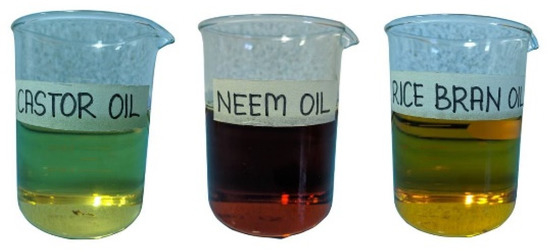
Figure 1.
Different types of MCFs delivered by MQL technique.
Table 2 shows the thermal conductivities of three types of MCFs.

Table 2.
Thermal conductivities of MCFs.
2.3. Setup and Drilling Parameters
Drilling experiments were performed on the Akira Seiki Performa SR3 computer numerical control (CNC) milling machine. This machine uses a Fanuc Oi-MD controller and has a maximum spindle speed of 11,000 RPM. Based on this machine specification and the literature review on the speed and feed for drilling Inconel 718, the machining parameters were selected as shown in Table 3. The through-holes drilling was used for the cutting method under MQL conditions. Figure 2 depicts the experimental setup of the drilling experiment for Inconel 718. The jig was used to fixate the workpiece in position properly and the carbide drills were clamped to the tool holder in the CNC milling machine. The cutting speeds that were used were 10 and 20 m/min with a constant feed rate of 0.015 mm/rev. Cutting parameters have been chosen based on a previous study by Kivak et al. [28] who, during the drilling of Inconel 718, used a TiAlN-coated carbide drill with 10 mm thickness of the workpiece. The minimum 10 m/min and maximum 20 m/min cutting speeds by Kivak et al. [28] have been implemented to study the effect of three different types of MCFs on the tool wear, tool life, surface roughness, dimensional accuracy, and chip thickness. According to previous findings by Choudury [29], at high cutting speeds (>30 m/min), when machining Inconel 718, carbide tools failed due to thermal softening of the cobalt binder phase and subsequent plastic deformation of the cutting edges.

Table 3.
Machining parameters.
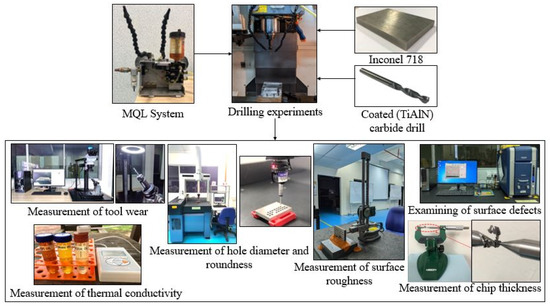
Figure 2.
Experimental setup and method for measurement of drilling data.
The tool wear form is mainly divided into two parts: the wear of the flank face and the wear of the chisel edge. For the tool wear measurement, the size of the flank face of the new cutting tool was measured using Stereo Microscopy System XST60 with the relevant image processing software before the drilling process started. The size of the tool wear was calculated by subtracting the unworn size after machining from the size of the flank face before machining. In the meantime, surface roughness was measured using an Accretech Handysurf E-35 equipped with a portable stylus, made by Tokyo Seimitsu, Tokyo, Japan. Surface roughness was recorded at four positions (0°, 90°, 180°, 270°) at each hole, parallel to the drill feed direction.
Hole diameter and roundness were measured using a Mitutoyo Coordinate Measuring Machine (CMM). The accuracy of the measurement was obtained by probing 12 points on the drilled hole at the entrance, middle, and exit locations. For the capturing of surface defects, a scanning electron microscope (SEM) was used under 500× magnification to display the surface defects of the first and last hole of the workpiece of Inconel 718. A tapered-nosed micrometer (model Mitutoyo IP 65) has been used to measure chip thickness. Average values of chip thickness were calculated to obtain accurate values. For the thermal conductivity measurement, a KD2 Pro Thermal Properties Analyzer was used. A sensor connected to the micro-controller was dipped into the MCFs at room temperature and each of the tests was repeated 10 times to ensure the reliability of the test results. The average of the 10 measurements was used as the final thermal conductivity value.
3. Results and Discussion
3.1. Tool Wear
The maximum flank wear versus the number of drilled holes using various types of non-edible vegetable oils such as castor, neem, and rice bran oils is depicted in Figure 3. The progression of the flank wear was measured after each hole for speeds of 10 and 20 m/min with a constant feed of 0.015 mm/rev. As indicated in Figure 3, the tool wear curves within all cutting speeds had reached the tool life criterion when the maximum flank wear crossed 0.15 mm. As is apparent, the castor oil was able to produce a greater number of holes compared to the neem and rice bran oils, regardless of the cutting speeds employed. It can be observed that the number of drilled holes using neem oil and rice bran oil was 21% and 50% lower than that of the castor oil at a cutting speed of 10 m/min, respectively. Meanwhile, at 20 m/min, the number of drilled holes significantly reduced by 29% and 59% using neem oil and rice bran oil, respectively, in comparison to castor oil. This is attributed to the high amount of ricinoleic acid and the high viscosity of castor oil compared to the other two oils [30,31]. It has been reported that a highly viscous oil reduces cutting force, workpiece temperature, and the progression of flank wear [32]. With the thick and strong layer of protective film formed on the workpiece surface by castor oil and its longer carbon chain, this eventually offered high anti-wear, friction, high strength, and durability of the lubricant film [33]. Apart from that, as mentioned by Ozcelik et al. [34], the high amount of saturated fatty acid in castor oil chemically reacts with metal surfaces to form a layer of fatty acid soap adsorption film. Due to the molecular attractions, the fatty acid molecules are deposited into metal surfaces to prevent friction and reduce wear.
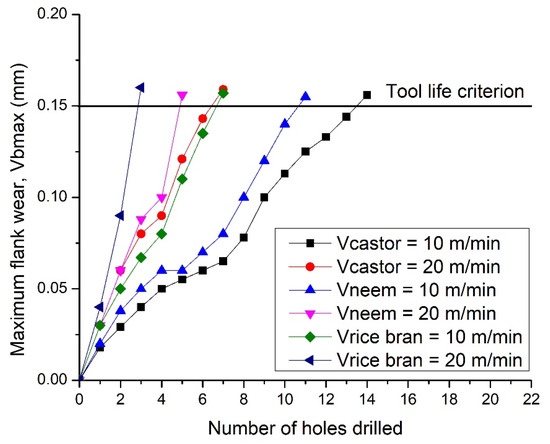
Figure 3.
Growth of maximum flank wear versus number of drilled holes for three MQL conditions of castor, neem, and rice bran oils.
As reported by Abdalla et al. [35], saturated fatty acids have excellent lubrication properties compared to that of unsaturated fatty acids. Saturated fatty acids protect lubricant film by enhancing the acting force between the molecules, therefore significantly reducing friction and wear. Overall, the lowest cutting speed of 10 m/min produces a greater number of holes drilled, compared to the 20 m/min cutting speed. The number of holes drilled at 10 m/min for castor, neem, and rice bran oils are 14, 11, and 7, whereas, at 20 m/min, they are 7, 5, and 3, respectively. It can be concluded that the coated (TiAlN) carbide drill experienced rapid tool wear at the highest cutting speed, 20 m/min, compared to the lowest cutting speed of 10 m/min. Since the Inconel 718 is a difficult-to-cut material, more heat is generated when machining at 20 m/min compared to the 10 m/min cutting speed. The temperature rise causes diffusion or an increase in the friction at the tool–chip interface, which can generate wear. When the cutting temperature and cutting pressure are too high, this can lead to a thermo-mechanical deformation of the cutting edge. As the thermal conductivity of Inconel 718 is relatively low, the heat transferred to the cutting tool is the main reason for tool wear [36]. This is consistent with past findings, as carbide tools experienced higher flank wear at high cutting speeds, with severe tool failure patterns nearly up to the tool life criterion [36,37]. It can be concluded that castor oil exhibits outstanding performance with respect to the tool life, while neem and rice bran oils experienced rapid tool wear at both higher and lower cutting speeds.
According to Xavior et al. and Khalil et al. [38,39], flank wear found on the cutting tool is the most common wear when machining Inconel 718. Flank wear is attributed to abrasion due to the friction between the clearance face of the cutting tool and the workpiece. This can be easily identified by tiny grooves that run parallel to the cutting direction. Based on this flank wear, the maximum length of the groove is commonly used in industry to determine the end of the effective tool life [40]. Figure 4 illustrates the maximum flank wear, Vbmax, for castor oil after drilling 14 and 7 holes at 10 m/min and 20 m/min, respectively. From Figure 4, it is apparent that the formation of a built-up edge (BUE) occurs at the same locations of the tool wear area. BUE is the adhesion of the workpiece material at the cutting edge of the cutting tool and can be prevented by implementing higher cutting speeds or by using MCFs [41].
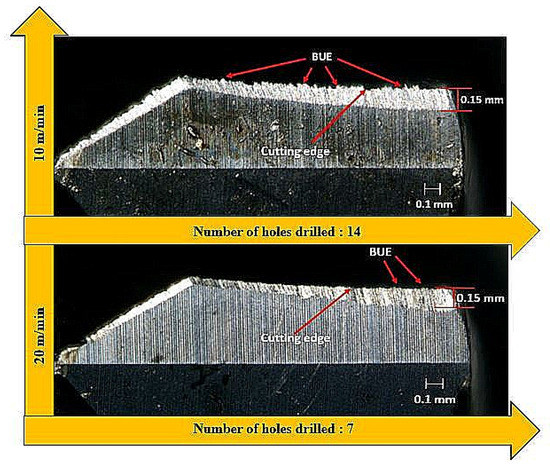
Figure 4.
Overview of maximum flank wear using castor oil at cutting speeds of 10 and 20 m/min.
3.2. Tool Life
Tool life is referred as the actual cutting time once the cutting tool is no longer usable. Table 4 presents the tool life and tool failure mode in drilling Inconel 718 under three types of MCFs with two cutting conditions. The trend of the tool life for each MCF was observed and is demonstrated in Figure 5. The longest tool life of 1582 s was attained at low cutting speed using castor oil, while the shortest tool life was 168 s at high cutting speed using rice bran oil. As is apparent, castor, neem, and rice bran oils have a short tool life at a cutting speed of 20 m/min compared to 10 m/min. The tool life was significantly reduced by 75.22%, 77.47%, and 78.76% for castor, neem, and rice bran oils at 20 m/min, respectively.

Table 4.
Tool life and tool failure mode data for different types of MCFs under two cutting conditions.
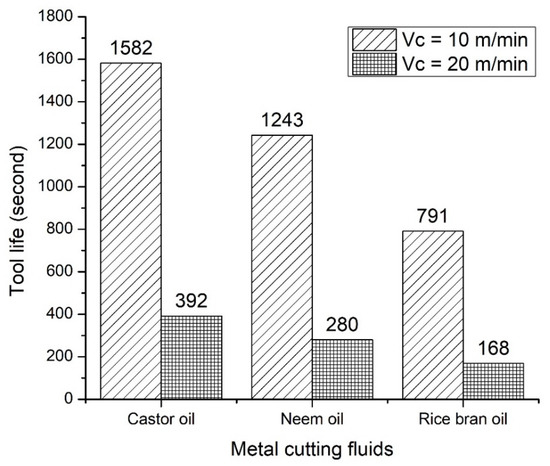
Figure 5.
Tool life versus MCFs under two cutting conditions using castor, neem, and rice bran oils.
Cutting speed has the greatest impact on tool life. According to many researchers, the tool life reduces with higher cutting speed [42,43]. High cutting speed leads to temperature rises in the cutting zone which accelerates the flank wear and weakens the cutting tool. As a result, premature tool failure, known as cutting tool breakage or catastrophic failure, occurs and the cutting process needs to stop for tool changing. Further, it is noted that longer tool life occurred with a minimum feed rate value. Therefore, the low feed rate value is kept constant within the experiment since the tool life is inversely proportional to cutting speed and feed rate. Overall, the results demonstrated the outstanding performance of castor oil as an MCF in comparison to neem and rice bran oils in achieving the maximum tool life at two cutting speeds. Tool life is highly significant for machinability evaluation and eliminating the time for cutting tool change. When the tool life expires, the reliability of the cutting tool influences the quality of the machined parts and productivity.
3.3. Surface Roughness
Surface roughness, Ra, is the average of the absolute value of profile heights over a given length (area), according to ASME B46. Surface roughness has an important role in the machining process as it defines the performance and quality of the end product. To achieve a better quality product, the proper machining parameters need to be chosen wisely. Rough surfaces are usually required as an indicator of the performance of the machine parts, since irregularities on the surface produce cracks, corrosion, rapid wear, and higher friction coefficients. Minimum surface roughness is important due to the increase in consumer demand for high-quality products. However, it is difficult and expensive to achieve high productivity without compromising quality. In relation to this issue, this study was conducted to indicate the effects of surface roughness on wear and friction at sliding contacts.
Figure 6 illustrates the graphical results of surface roughness of the drilled holes using castor, neem, and rice bran oils under cutting speeds of 10 and 20 m/min. It can be observed that the surface roughness values during initial drilling for all types of MCFs using the MQL technique were within 1.095 to 1.633 µm. As drilling progresses, further intermittent and inconsistent surface roughness values were recorded in the range of 1.095 to 1.980 µm, until it reached the tool life criteria. As stated by a previous study, MQL achieved lower surface roughness at a lower cost compared to flood lubrication [40]. It is evident that the surface roughness using castor, neem, and rice bran oils recorded a roughness value of less than 2 μm. It should be noted that the overall surface roughness requirement for finished bolt holes in turbine discs is given as Ra < 1.6 μm, and for pre-drilled holes, is Ra < 2 μm in drilling Inconel 718 [44,45].

Figure 6.
Surface roughness against the number of holes drilled using different MCFs under two cutting conditions.
Further evaluation on the average surface roughness of castor, neem, and rice bran oils is shown in Figure 7. At the cutting speed of 20 m/min, the average surface roughness values for castor, neem, and rice bran oils were 1.455, 1.593, and 1.628 µm, respectively. A slight reduction of 9% and 11% was recorded when using castor in comparison to neem and rice bran oils, respectively. According to Benardos et al. [46], MCFs generally affect surface roughness in three different ways. Firstly, it absorbs the heat generated during the cutting process to cool the cutting tool and workpiece. Secondly, MCFs minimize the friction between the tool–chip and tool–workpiece interfaces, and lastly, MCFs function as a flushing medium for chip and wear particles. Consequently, the presence of MCFs improves the quality of a workpiece in terms of surface roughness.

Figure 7.
Average surface roughness versus cutting speed using castor, neem, and rice bran oils.
It also can be noticed that at the lower cutting speed of 10 m/min, the surface roughness deteriorated rapidly. An increment of 9% and 8% of surface roughness was evident for castor and neem oils, respectively, when drilling at 10 m/min. Based on past studies [47,48,49], surface roughness was improved at a higher cutting speed due to a thermal softening of material at high speed with the likelihood of surface defects being wiped out during the drilling process [36]. In addition, an increase in the cutting speed reduced the formation of BUE. Since high cutting speeds lead to temperature rises, the BUE on the cutting edge lost its strength and hardness, and in the subsequent cutting processes, the BUE was unable to resist tensions on itself and it was removed from the cutting edge [50]. Hence, high cutting speeds reduced the formation of BUE, resulting in lower surface roughness of the workpiece.
In contrast, the surface roughness value of the drilled hole while using rice bran oil has a significant reduction of 15% for a drilling speed of 10 m/min. This is attributed to the lower viscosity of rice bran oil compared to castor and neem oils. Previous findings from Lin et al. [51] stated that the lower viscosity of oil reduced the coefficient of friction, thereby improving the surface roughness at a lower cutting speed. Although it is noticeable that the lowest surface roughness value of the Inconel 718 was at 10 m/min while using the rice bran oil, the cutting tool was rapidly worn and reached the tool life criterion after drilling seven holes. Regarding this, the number of drilled holes using rice bran oil was less than the castor and neem oils. It can be suggested that, when drilling Inconel 718, high cutting speeds and low feed rates are necessary. Past studies reported that the machining of difficult-to-cut materials requires a low feed rate, whereas, in machining soft material, the feed rate has no significant effect on the surface roughness [52,53].
3.4. Surface Defects
Surface defect is defined as an imperfection, damage, or deformation at the exterior surface of the machined component. The presence of surface defects can significantly affect the corrosion resistance, coating, and mechanical properties. It is primarily affected by various factors including tool geometry, machining parameters, type of machining, tool wear, cutting temperatures, and cutting forces. There are various types of surface defects which include smeared material, long grooves, micro-cracks, metal debris, and feed marks.
The results of surface defects on the drilled holes at a low cutting speed of 10 m/min using castor and neem oils showed the appearance of long grooves, debris, and feed marks as depicted in Figure 8 and Figure 9, respectively. Visible feed marks at different cutting speeds for castor and neem oils can be observed. As stated in previous research, the main surface defects on the machined surface of nickel-based alloys are feed marks and the deposition of foreign materials over the machined surface as a result of high thermal and mechanical loading [54]. The feed marks occurred as a result of an increase in feed. Long grooves and metal debris are also formed, due to the developed BUE, which was detached from the cutting tool and transferred to the machined surface [55,56]. These long grooves were also influenced by the tool wear and the chips adhered to the cutting tool [57].
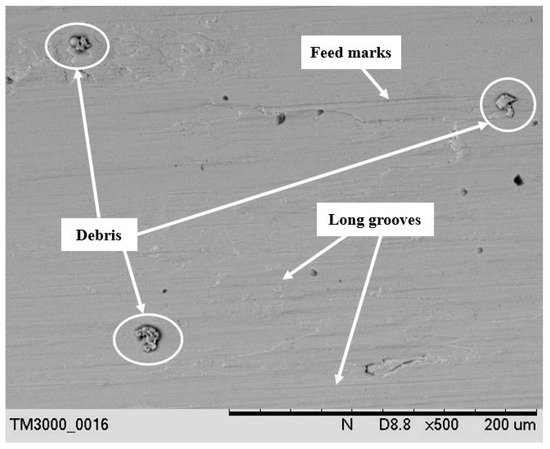
Figure 8.
Surface defects on the drilled hole using castor oil at cutting speed of 10 m/min and feed of 0.015 mm/rev.
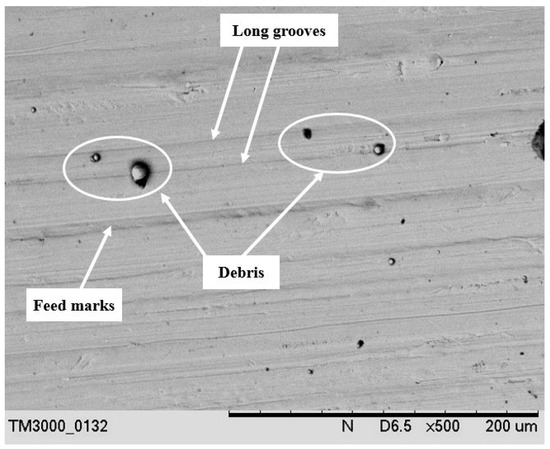
Figure 9.
Surface defects on the drilled hole using neem oil at cutting speed of 10 m/min and feed of 0.015 mm/rev.
Detailed observations on the machined surface at a high cutting speed of 20 m/min (using castor and neem oils) are depicted in Figure 10 and Figure 11, respectively. When cutting speed was increased to 20 m/min, smeared materials were formed on the machined surface. This is attributed to the rise in cutting temperature, under which the workpiece material is more prone to plasticization. Since plastic deformation was dominated by heat, localized high temperatures at the tool–workpiece interfaces resulted in smeared materials on the machined surface [58].
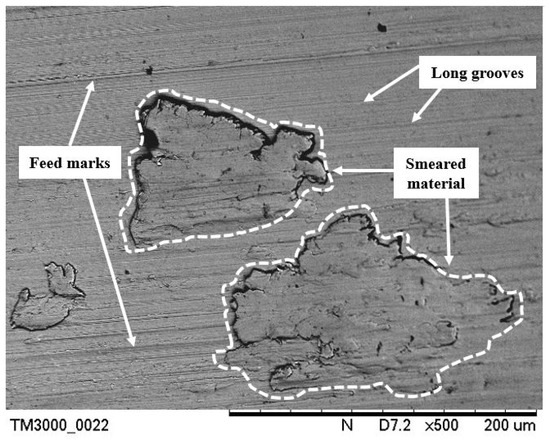
Figure 10.
Surface defects on the drilled hole using castor oil at cutting speed of 20 m/min and feed of 0.015 mm/rev.
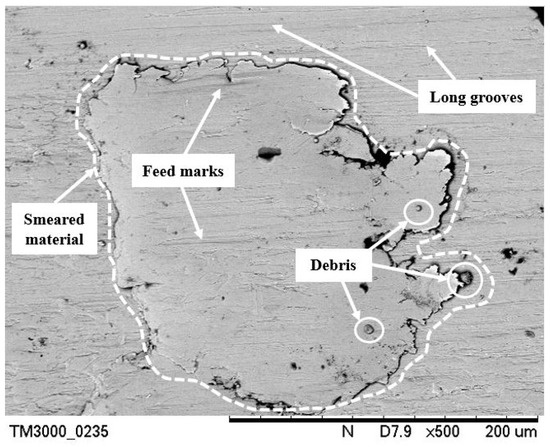
Figure 11.
Surface defects on the drilled hole using neem oil at cutting speed of 20 m/min and feed of 0.015 mm/rev.
3.5. Hole Diameter
In modern manufacturing technologies, the industry faces a lot of difficulties regarding dimensional accuracy and precision, particularly when operating with difficult-to-cut materials. Secondary processes such as boring, reaming, and honing have been conducted to improve the hole quality; however, these processes increase the manufacturing time and reduce the productivity. To improve the hole quality and reduce the secondary processes that, in turn, minimize the manufacturing costs, several factors such as cutting speed, feed rate, tool diameter, material, and geometry should be chosen wisely.
Figure 12 shows the hole diameters at three depth locations (entry, middle, exit) of the drilled Inconel 718 for different types of MCFs. It is apparent that the hole diameter for the three depth locations was marginally higher than the nominal diameter of 6.000 mm for the two cutting speeds. The closer the value of the drilled diameter to the nominal diameter, the better the accuracy, thus producing a lower error. All holes analyzed were oversized by 0.013 mm to 0.043 mm. At relatively high cutting speeds, the deviation on hole diameter increases at the entrance, middle, and exit of the hole. This is because as the spindle rotation speed increases, the vibration during entrance of the cutting tool also increases [59]. At 10 m/min, rice bran oil performed well in terms of the deviation of holes diameter, which contributed to the lowest deviation diameter (0.013 mm) at the exit of the drilled hole. Meanwhile, at 20 m/min, rice bran oil shows the highest deviation diameter (0.043 mm) at the entrance of the drilled hole.
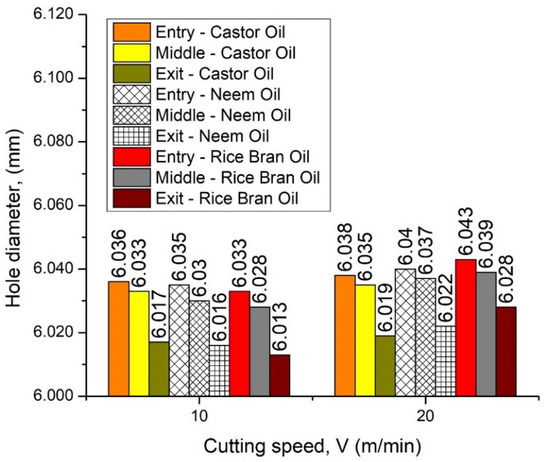
Figure 12.
Hole diameter in drilling Inconel 718 using castor, neem, and rice bran oils for two cutting speeds.
Apart from that, the presence of MCFs also affects the diameter of the drilled holes. The MCFs help to reduce friction, heat generation, and carried away heat from the workpiece and cutting tool. Furthermore, MCFs can prevent the hot chips from clogging the flutes, thus reducing the temperature of the holes drilled. When drilling a material with poor thermal conductivity, more heat is accumulated at the cutting zone, leading to severe thermal distortion and poor hole quality. Hence, the hole diameter values were less significant with the presence of MCFs. It can be inferred that a hole diameter deviation is usually the effect of deflection, vibration, wear, and lack of lubrication. At both high and low cutting speeds, the deviation at the entrance of a hole was greater than at the exit of the hole. This is because when the cutting tool touches the workpiece, the vibration will reach its maximum value. Furthermore, the spring-back phenomenon might occur due to elastic deformation of the workpiece material during cutting tool movement [60].
3.6. Roundness
Roundness comprises a shape error when a geometric element deviates from its theoretical circular shape. These errors occur due to lack of rigidity (inadequate workpiece fixations and machine tool conditions), tool wear, and temperature variations. In the drilling process, circularity errors occur when the hole diameter is not uniform with its depth of cut. The measurement of roundness is essential for various applications. One of the most significant fundamental forms of engineering components is the circular cross section. Circular forms can be found in a wide range of applications including bearing surfaces such as ball bearings and rotating shafts [60].
Figure 13 shows the result of roundness in drilling the Inconel 718 using castor, neem, and rice bran oils at two cutting speeds. The roundness was determined at three different depth locations (2, 5, and 8 mm from the top of the workpiece surface) of the holes drilled using the same technique as the hole diameter. The graphical result of roundness illustrated in Figure 13 depicts that the roundness of the holes drilled varies from 0.0085 to 0.0178 mm with respect to the minimum and maximum values. It is apparent that the lowest value was obtained at the entry of the drilled hole for rice bran oil at a cutting speed of 20 m/min, whereas the highest value was recorded for the castor oil at the entry of the drilled hole while drilling at 10 m/min.
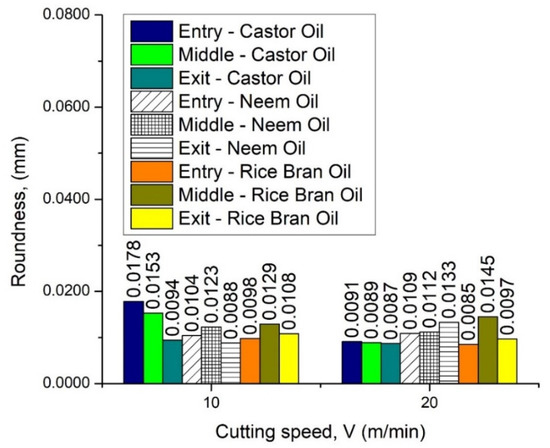
Figure 13.
Roundness in drilling Inconel 718 using castor, neem, and rice bran oils at two cutting speeds.
The smallest and largest values of roundness for the castor oil at the exit and entrance of the drilled hole are 0.0087 mm and 0.0178 mm for cutting speeds of 20 m/min and 10 m/min, respectively. For the neem oil, the roundness values recorded was 0.0088 mm and 0.0133 mm, which implies the lowest and highest value at the exit of the drilled hole for both cutting speeds. Meanwhile, the smallest and greatest values of roundness for rice bran oil are 0.0085 mm and 0.0145 mm at the entrance and middle of the drilled holes at 20 m/min, respectively. From the observation, there is no significant trend in the variation of hole roundness with increasing depth in drilling Inconel 718 using castor, neem, and rice bran oils. Nevertheless, an inconsistent reading was obtained at the three different depths of the hole. This result is in agreement with findings from Sultan et al. [55], who suggested that there is no clear pattern, and no significant difference was achieved when measuring roundness at different cutting speeds and feed rates. Zeilmann et al. [61] demonstrated a similar result under the MQL, flood, and dry cutting conditions for drilling AISI P20 steel. Similar to our findings, a significant trend cannot be evaluated for roundness values at different depths during the drilling of Inconel 718.
3.7. Chip Thickness
Chip thickness is one of the important parameters for machinability evaluations, as it indicates the deformation (elongation) of the chip in its thickness. It defines other significant parameters such as contact stresses on the tool–chip interface, amount of plastic deformation being removed, tool life, and cutting force. Chip thickness depends on the workpiece material, cutting tool geometry, types of cutting fluids, and machining parameters such as cutting speed, feed rate, and depth of cut.
Table 5 and Figure 14 present the average chip thickness after drilling Inconel 718 at two cutting speeds with constant feed rate. Based on Figure 14, the reduction of 5%, 9%, and 14% in the chip thickness was demonstrated by castor, neem, and rice bran oil, respectively. It is evident that chip thickness is reduced at a higher cutting speed. Previous research explained that the reduction of chip thickness at a higher cutting speed is caused by the reduction in material removal rate per revolution and is influenced by the heat generated during the machining process [62,63].

Table 5.
The average chip thickness using different types of MCFs at two cutting speeds and a constant feed rate.

Figure 14.
Average chip thickness at two cutting speeds while drilling with castor, neem, and rice bran oils.
Drilling of Inconel 718 with castor oil was attributed to a 5% and 16% reduction in chip thickness when compared to the neem and rice bran oils at a cutting speed of 20 m/min, respectively. The lowest chip thickness of 0.22 mm was observed at a cutting speed of 20 m/min for the castor oil. The lubrication film formed by the castor oil significantly reduced the contact area and friction at the shear zone, hence, producing thinner chips. It is noticeable that the oil viscosity also has a major influence on the chip thickness. If the viscosity of oil is low, the lubrication film is unable to separate tool–chip interfaces, hence, increasing the contact area and friction to produce thicker chips. According to Simpson et al. [64], the less viscous oil has a high evaporative loss which deteriorates the formation of an adhered oil layer at the tool–chip interfaces. Rice bran oil has the lowest viscosity and produced the thickest chips owing to the lack of lubrication film [30,31].
3.8. Thermal Conductivity
The thermophysical properties of MCFs are very important for evaluating machinability performance. Among the thermophysical properties, thermal conductivity is considered the most important requirement of MCFs for heat transfer applications. Thermal conductivity plays an important role in the heat dissipation process, which can alleviate the growth in tool wear and sustain a reasonable tool life [65]. In the metal cutting process, a large amount of heat is generated because of shearing action, compression in the shear zone, and friction between sliding surfaces. A significant increase in the thermal conductivity of MCFs reduces the heat generation, thus, lowering the cutting temperature.
When machining difficult-to-cut material, a rise in cutting temperature lowers the tool strength, and increases the tool wear that attributed to higher surface roughness, incorrect dimensional accuracy, high cutting force, softening of cutting edge, and tool failure. According to Pervaiz et al. [66], chemical wear mechanisms including thermal cracking and diffusion are considered under a high-temperature region. Therefore, heat should be continuously dissipated away from the cutting zone so that the temperature is maintained within desirable limits. Based on Figure 15, castor oil has the highest thermal conductivity compared to neem and rice bran oils. The highest thermal conductivity of castor oil reduced the heat accumulated at the cutting zone and, as a result, the cutting temperature was reduced and the tool wear was minimized. The high thermal conductivity leads to the anti-friction properties of the MCFs, thus decreasing the surface roughness of workpiece significantly. Due to the excellent thermal conductivity of MCFs, their application in high-speed machining on difficult-to-cut materials is highly effective. To reduce the application of mineral-based oil, the utilization of vegetable-based oil MCFs with high thermal conductivity must be implemented.
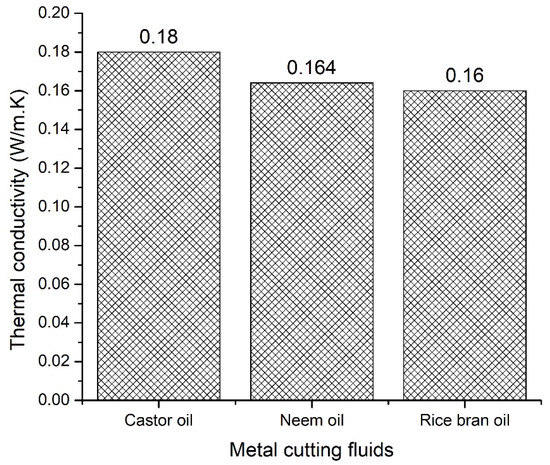
Figure 15.
Thermal conductivities of castor, neem, and rice bran oil at room temperature.
4. Conclusions
This study highlighted the machinability performance of Inconel 718 with respect to the tool wear, tool life, surface integrity, dimensional accuracy, and chip thickness under various MQF conditions. To achieve the objectives of the study, three different MCFs have been used at two cutting speeds (10 and 20 m/min) with a constant feed (0.015 mm/rev). According to analysis and results, the following conclusions were drawn:
- (a)
- The longest tool life was obtained using castor oil at a cutting speed of 10 m/min with an improvement of 21.43% and 50% compared to neem and rice bran oils, respectively. Eventually, castor oil produced the highest number of drilled holes compared to neem and rice bran oils for all cutting speeds;
- (b)
- A cutting speed of 20 m/min and a feed of 0.015 mm/rev produced better surface roughness for castor and neem oils. In contrast, rice bran oil exhibited better surface roughness at a cutting speed of 10 m/min due to its low viscosity to reduce friction at a higher cutting speed. Thus, castor oil outperformed neem and rice bran oils owing to the lowest surface roughness with a greater number of drilled holes. The surface roughness using castor oil decreased by 8.66% and 10.63% compared to neem and rice bran oils, respectively;
- (c)
- Surface defects of the drilled surface at a 20 m/min cutting speed displayed smeared material compared to the 10 m/min cutting speed, which only consisted of long grooves, metal debris, and feed marks for all MCFs;
- (d)
- The hole diameter increased with changes in cutting speed due to the higher spindle rotation speed and cutting tool vibrations. Meanwhile, the roundness of the drilled holes showed inconsistent readings for different types of MCFs;
- (e)
- The thinnest chip was produced by castor oil at a cutting speed of 20 m/min, in which it recorded a reduction of 4.35% and 14.06% in chip thickness compared to neem and rice bran oils, respectively. The chip thickness also depends on the viscosity of the oil. Hence, the highest viscosity of castor oil produced the thinnest chip, while the lowest viscosity of rice bran oil generated the thickest chip;
- (f)
- Castor oil showed the highest thermal conductivities, which are 8.89% and 11.11% higher than neem and rice bran oils, respectively, to reduce the heat accumulated at the cutting zone, hence, reducing cutting temperature and tool wear.
Author Contributions
Conceptualization, N.S.S.S. and M.N.M.; methodology, N.S.S.S.; formal analysis, N.S.S.S., M.N.M. and A.I.A.; software, N.S.S.S., M.N.M. and T.C.L.; investigation, N.S.S.S., M.N.M. and T.C.L.; resources, M.N.M.; writing–original draft preparation, N.S.S.S., M.N.M., T.C.L. and A.I.A.; writing—review and editing, N.S.S.S., M.N.M., W.A.W.H. and M.D.; supervision, M.N.M. and T.C.L.; project administration, M.N.M.; funding acquisition, M.N.M. All authors have read and agreed to the published version of the manuscript.
Funding
This research was funded by the Ministry of Higher Education through the Fundamental Research Grant Scheme (FRGS) No: FRGS/1/2019/TK03/UNIMAP/02/11.
Data Availability Statement
Not applicable.
Acknowledgments
The authors acknowledged the fund provided by the Ministry of Higher Education through the Fundamental Research Grant Scheme (FRGS) No: FRGS/1/2019/TK03/UNIMAP/02/11. Thanks to the Faculty of Mechanical Engineering Technology, Universiti Malaysia Perlis for the lab facilities provided.
Conflicts of Interest
The authors declare no conflict of interest.
References
- Xavior, M.A.; Patil, M.; Maiti, A. Machinability Studies on Inconel 718. IOP Conf. Ser. Mater. Sci. Eng. 2016, 149, 012019. [Google Scholar] [CrossRef]
- Ali, M.A.M.; Azmi, A.I.; Murad, M.N. Roles of New Bio-Based Nanolubricants Towards Eco-Friendly and Improved Machinability of Inconel 718 Alloys. Tribol. Int. 2020, 144, 106106. [Google Scholar] [CrossRef]
- Hegab, H.; Kishawy, H.A. Towards Sustainable Machining of Inconel 718 Using Nano-Fluid Minimum Quantity Lubrication. J. Manuf. Mater. Process 2018, 2, 50. [Google Scholar] [CrossRef]
- Khanafer, K.; Eltaggaz, A.; Deiab, I. Toward Sustainable Micro-Drilling of Inconel 718 Superalloy Using MQL-Nanofluid. Int. J. Adv. Manuf. Tech 2020, 107, 3459–3469. [Google Scholar] [CrossRef]
- Tomantis, L. Evaluation of Carcinogenic Risks to Humans/World Health Organization. IARC Monogr. Eval. Carcinog. Risks Hum. 2012, 100, 9–562. [Google Scholar]
- Mir, M.J.; Wani, M.F. The influence of Cutting Fluid Conditions and Machining Parameters on Cutting Performance and Wear Mechanism of Coated Carbide Tools. J. Tribol. 2018, 18, 58–80. [Google Scholar]
- Meena, A.; El Mansori, M. Study of Dry and Minimum Quantity Lubrication Drilling of Novel Austempered Ductile Iron (ADI) for Automotive Applications. Wear 2011, 271, 2412–2416. [Google Scholar] [CrossRef]
- Murad, M.N.; Sharif, S.; Rahim, E.A. Effect of Drill Point Angle on Surface Integrity When Drilling Titanium Alloy. Adv. Mater. Res. 2014, 845, 966–970. [Google Scholar] [CrossRef]
- Pal, A.; Chatha, S.S.; Sidhu, H.S. Experimental Investigation on the Performance of MQL Drilling of AISI 321 Stainless Steel Using Nano-Graphene Enhanced Vegetable-Oil-Based Cutting Fluid. Tribol. Int. 2020, 151, 106508. [Google Scholar] [CrossRef]
- Lisowicz, J.; Habrat, W.; Krupa, K. Influence of Minimum Quantity Lubrication Using Vegetable-Based Cutting Fluids on Surface Topography and Cutting Forces in Finish Turning of Ti-6Al-4V. Adv. Sci. Technol. Res. J. 2020, 16, 95–103. [Google Scholar] [CrossRef]
- Yin, Q.; Li, C.; Dong, L. Effects of Physicochemical Properties of Different Base Oils on Friction Coefficient and Surface Roughness in MQL Milling AISI 1045. Int. J. Precis. Eng. Manuf. Green Technol. 2021, 8, 1629–1647. [Google Scholar] [CrossRef]
- Shashidhara, Y.M.; Jayaram, S.R. Vegetable oils as a potential cutting fluid- an evolution. Tribol. Int. 2010, 43, 1073–1081. [Google Scholar] [CrossRef]
- Nguyen, T.K.; Do, I.; Kwon, P. A Tribological Study of Vegetable Oil Enhanced by Nano-Platelets and Implication In MQL Machining. Int. J. Precis. Eng. Manuf. 2012, 13, 1077–1083. [Google Scholar] [CrossRef]
- Lawal, S.A.; Choudhury, I.A.; Nukman, Y. A Critical Assessment of Lubrication Techniques in Machining Processes: A Case for Minimum Quantity Lubrication Using Vegetable Oil-Based Lubricant. J. Clean. Prod. 2013, 41, 210–221. [Google Scholar] [CrossRef]
- Somashekaraiah, R.; Suvin, P.S.; Gnanadhas, D.P. Eco-Friendly, Non-Toxic Cutting Fluid for Sustainable Manufacturing and Machining Processes. Tribol. Online 2016, 11, 556–567. [Google Scholar] [CrossRef]
- Murad, M.N.; Sharif, S.; Rahim, E.A. Comparative Evaluation of Physicochemical Properties of Jatropha Curcas Seed Oil for Coolant-Lubricant Application. AIP Conf. Proc. 2017, 1885, 020186. [Google Scholar] [CrossRef]
- Gajrani, K.K.; Sankar, M.R. Past and Current Status of Eco-Friendly Vegetable Oil Based Metal Cutting Fluids. Mater. Today Proc. 2017, 4, 3786–3795. [Google Scholar] [CrossRef]
- Saleem, M.Q.; Mehmood, A. Eco-Friendly Precision Turning of Superalloy Inconel 718 Using MQL Based Vegetable Oils: Tool Wear and Surface Integrity Evaluation. J. Manuf. Proc. 2022, 73, 112–127. [Google Scholar] [CrossRef]
- Atabani, A.E.; Silitonga, A.S.; Ong, H.C. Non-Edible Vegetable Oils: A Critical Evaluation of Oil Extraction, Fatty Acid Compositions, Biodiesel Production, Characteristics, Engine Performance and Emissions Production. Renew. Sustain. Energy Rev. 2013, 18, 211–245. [Google Scholar] [CrossRef]
- Ahmad, A.L.; Mat Yasin, N.H.; Derek, C.J.C. Microalgae as a Sustainable Energy Source for Biodiesel Production: A Review. Renew. Sustain. Energy Rev. 2011, 15, 584–593. [Google Scholar] [CrossRef]
- Singh, Y.; Farooq, A.; Raza, A. Sustainability of a non-Edible Vegetable Oil Based Bio-Lubricant for Automotive Applications: A Review. Proc. Saf. Environ. Prot 2017, 111, 701–713. [Google Scholar] [CrossRef]
- Maleque, M.A.; Masjuki, H.H.; Sapuan, S.M. Vegetable-Based Biodegradable Lubricating Oil Additives. Ind. Lubr. Tribol. 2003, 55, 137–143. [Google Scholar] [CrossRef]
- Katna, R.; Suhaib, M.; Agrawal, N. Non-Edible Vegetable Oil-Based Cutting Fluids for Machining Processes—A Review. Mater. Manuf. Proc. 2019, 35, 1–32. [Google Scholar] [CrossRef]
- Elmunafi, M.H.S.; Kurniawan, D.; Noordin, M.Y. Use of Castor Oil as Cutting Fluid in Machining of Hardened Stainless Steel with Minimum Quantity of Lubricant. Procedia CIRP 2015, 26, 408–411. [Google Scholar] [CrossRef]
- Katiyar, P.K.; Singh, P.K.; Singh, R. Modes of Failure of Cemented Tungsten Carbide Tool Bits (WC/Co): A Study of Wear Parts. Int. J. Refract. Met. Hard Mater. 2016, 54, 27–38. [Google Scholar] [CrossRef]
- Yin, Q.; Liu, Z.; Wang, N. Recent Progress of Machinability and Surface Integrity for Mechanical Machining Inconel 718: A Review. Int. J. Adv. Manuf. Technol. 2016, 109, 215–245. [Google Scholar] [CrossRef]
- Danish, M.; Gupta, M.K.; Rubaiee, S. Influence of Graphene Reinforced Sunflower Oil on Thermo-Physical, Tribological and Machining Characteristics of Inconel 718. J. Mater. Res. Technol. 2021, 15, 135–150. [Google Scholar] [CrossRef]
- Kivak, T. The Effect of Cutting Paramaters on the Hole Quality and Tool Wear During the Drilling of Inconel 718. Gazi Univ. J. Sci. 2012, 25, 533–540. [Google Scholar]
- Choudhury, I.A.; El-Baradie, M.A. Machining Nickel Base Superalloys: Inconel 718. Proc. Inst. Mech. Eng. Part B J. Eng. Manuf. 1998, 212, 195–206. [Google Scholar] [CrossRef]
- Olawale, K.B.; Aji, I.S.; Ejilah, R.I. Lubricity Assessment of Neem and Castor Oils and Their Blends in Machining Mild Steel. USA Acad. Sci. Res. J. Eng. Technol. Sci. 2018, 48, 128–137. [Google Scholar]
- Suresh Kannan, I.; Karthikeyan, S.; Ravikumar, K. Lubrication Performance of Castor Oil Blended with Other Vegetable Oils in Grinding of Inconel 625. IOP Conf. Ser. Mater. Sci. Eng. 2020, 923, 012027. [Google Scholar] [CrossRef]
- Werda, S.; Duchosal, A.; Quilliec, G.L. Minimum Quantity Lubrication: Influence of The Oil Nature on Surface Integrity. Procedia CIRP 2016, 45, 287–290. [Google Scholar] [CrossRef]
- Li, B. Grinding Temperature and Energy Ratio Coefficient in MQL Grinding of High-Temperature Nickel-Base Alloy by Using Different Vegetable Oils as Base Oil. Chin. J. Aeronaut. 2016, 29, 1084–1095. [Google Scholar] [CrossRef]
- Ozcelik, B.; Kuram, E.; Demirbas, E. Effects of Vegetable-Based Cutting Fluids on the Wear in Drilling. Sadhana Ind. Acad. Sci. 2013, 38, 687–706. [Google Scholar] [CrossRef]
- Abdalla, H.S.; Patel, S. The Performance and Oxidation Stability of Sustainable Metalworking Fluid Derived from Vegetable Extracts. Proc. Inst. Mech. Eng. Part B J. Eng. Manuf. 2006, 220, 2027–2040. [Google Scholar] [CrossRef]
- D’Addona, D.M.; Raykar, S.J.; Narke, M.M. High Speed Machining of Inconel 718: Tool Wear and Surface Roughness Analysis. Procedia CIRP 2017, 62, 269–274. [Google Scholar] [CrossRef]
- Rosnan, R.; Azmi, A.I.; Murad, M.N. Effects of Cutting Parameters on Tool Wear and Thrust Force in Drilling Nickel-Titanium (Niti) Alloys Using Coated and Uncoated Carbide Tools. Key Eng. Mater. 2018, 791, 111–115. [Google Scholar] [CrossRef]
- Xavior, M.A.; Manohar, M.; Jeyapandiarajan, P. Tool Wear Assessment During Machining of Inconel 718. Procedia Eng. 2017, 174, 1000–1008. [Google Scholar] [CrossRef]
- Khalil, A.N.M.; Azmi, A.I.; Murad, M.N. Coupled Effects of Vortex Tube Hybrid Cooling with Minimal Quantity Reinforced Nanoparticle Lubricants in Turning Niti Alloys. Int. J. Adv. Manuf. Technol. 2019, 105, 3007–3015. [Google Scholar] [CrossRef]
- Bertolini, R.; Ghiotti, A.; Bruschi, S. Graphene Nanoplatelets as Additives to MQL For Improving Tool Life in Machining Inconel 718 alloy. Wear 2021, 476, 203656. [Google Scholar] [CrossRef]
- Azlan, U.A.A. Metallurgy for the Non-Metallurgist, Second Edition. MATEC Web. Conf. 2017, 97, 1076. [Google Scholar] [CrossRef]
- Elmunafi, M.H.S.; Noordin, M.Y.; Kurniawan, D. Tool Life of Coated Carbide Cutting Tool When Turning Hardened Stainless Steel Under Minimum Quantity Lubricant Using Castor Oil. Procedia Manuf. 2015, 2, 563–567. [Google Scholar] [CrossRef]
- Talib, N.; Rahim, E.A. The Effect of Tribology Behavior on Machining Performances When Using Bio-Based Lubricant as A Sustainable Metalworking Fluid. Procedia CIRP 2016, 40, 504–508. [Google Scholar] [CrossRef]
- Eckstein, M.; Mankova, I. Monitoring of Drilling Process for Highly Stressed Aeroengine Components. Procedia CIRP 2012, 1, 587–592. [Google Scholar] [CrossRef]
- Eckstein, M.; Mankova, I.; Vrabel, M. Comparison of Sensors Signal Quality When Drilling Inconel 718. Procedia CIRP 2015, 33, 227–232. [Google Scholar] [CrossRef][Green Version]
- Benardos, P.G.; Vosniakos, G.C. Prediction of Surface Roughness in CNC Face Milling Using Neural Networks and Taguchi’s Design of Experiments. Robot. Comput. Integr. Manuf. 2002, 18, 343–354. [Google Scholar] [CrossRef]
- Mohsan, A.U.H.; Liu, Z.; Padhy, G.K. A Review on the Progress Towards Improvement in Surface Integrity of Inconel 718 Under High Pressure and Flood Cooling Conditions. Int. J. Adv. Manuf. Technol. 2016, 91, 107–125. [Google Scholar] [CrossRef]
- Aramesh, M.; Montazeri, S.; Veldhuis, S.C. A Novel Treatment for Cutting Tools for Reducing the Chipping and Improving Tool Life During Machining of Inconel 718. Wear 2018, 414–415, 79–88. [Google Scholar] [CrossRef]
- Liu, Y.; Xu, D.; Agmell, M. Numerical and Experimental Investigation of Tool Geometry Effect on Residual Stresses in Orthogonal Machining of Inconel 718. Simul. Model. Pract. Theory 2021, 106, 102187. [Google Scholar] [CrossRef]
- Bahce, E.; Ozel, C. Experimental Investigation of the Effect of Machining Parameters on the Surface Roughness and the Formation of Built-Up Edge (BUE) in the Drilling of Al 5005. Tribol. Eng. 2013, 32, 137–144. [Google Scholar]
- Lin, L. Assessment of Effects of Surface Roughness and Oil Viscosity on Friction Coefficient Under Lubricated Rolling-Sliding Conditions (Analysis of Lubrication Modes Based on EHL theory). Komatsu Technol. Rep. 2013, 59, 1–7. [Google Scholar]
- Ozel, T.; Kong Hsu, T.; Zeren, E. Effects of Cutting-Edge Geometry, Workpiece Hardness, Feed Rate and Cutting Speed on Surface Roughness and Forces in Finish Turning of Hardened AISI H13 steel. Int. J. Adv. Manuf. Technol. 2005, 25, 262–269. [Google Scholar] [CrossRef]
- Makadia, A.J.; Nanavati, J.I. Analysis of surface Roughness in Turning with Coated Carbide Cutting Tools: Prediction Model and Cutting Conditions Optimization. In Proceedings of the 5th Inthernational & 26th All India Manufacturing Technology, Design and Research Conference (AIMTDR 2014), Guwahati, India, 12–14 December 2014; Volume 20, pp. 1–6. [Google Scholar]
- Behera, B.C.; Alemayehu, H.; Ghosh, S. A Comparative Study of Recent Lubri-Coolant Strategies for Turning of Ni-Based Superalloy. J. Manuf. Proc. 2017, 30, 541–552. [Google Scholar] [CrossRef]
- Zhou, J.M. An Investigation of Surface Damage in the High Speed Turning of Inconel 718 with Use of Whisker Reinforced Ceramic Tools. J. Mater. Proc. Technol. 2012, 212, 372–384. [Google Scholar] [CrossRef]
- Thakur, A.; Gangopadhyay, S. State-of-The-Art in Surface Integrity in Machining of Nickel-Based Super Alloys. Int. J. Mach. Tools Manuf. 2016, 100, 25–54. [Google Scholar] [CrossRef]
- Rajaguru, J.; Arunachalam, N. Investigation on Machining Induced Surface and Subsurface Modifications on the Stress Corrosion Crack Growth Behaviour of Super Duplex Stainless Steel. Corros. Sci. 2018, 141, 230–242. [Google Scholar] [CrossRef]
- Zhao, Y.Z.; Guo, K.; Sivalingam, V. Surface Integrity Evolution of Machined Niti Shape Memory Alloys After Turning Process. Adv. Manuf. 2021, 9, 446–456. [Google Scholar] [CrossRef]
- Sultan, A.Z.; Sharif, S.; Kurniawan, D. Effect of Machining Parameters on Tool Wear and Hole Quality of AISI 316L Stainless Steel in Conventional Drilling. Procedia Manuf. 2015, 2, 202–207. [Google Scholar] [CrossRef]
- Kurt, M.; Kaynak, Y.; Bagci, E. Evaluation of Drilled Hole Quality in Al 2024 alloy. Int. J. Adv. Manuf. Technol. 2008, 37, 1051–1060. [Google Scholar] [CrossRef]
- Zeilmann, R.P.; Vacaro, T.; Bordin, F.M. Effects of the Cutting Fluid Reduction on the Dimensional Quality of Holes. Proc. Inst. Mech. Eng. Part B J. Eng. Manuf. 2015, 229, 1314–1323. [Google Scholar] [CrossRef]
- Wagner, V.; Baili, M.; Dessein, G. The Relationship between the Cutting Speed, Tool Wear, and Chip Formation during Ti-5553 Dry Cutting. Int. J. Adv. Manuf. Technol. 2015, 76, 893–912. [Google Scholar] [CrossRef]
- Talib, N.; Md Nasir, R.; Rahim, E.A. Investigation on the Tribological Behaviour of Modified Jatropha Oil with Hexagonal Boron Nitride Particles as A Metalworking Fluid for Machining Process. Int. J. Integr. Eng. 2018, 10, 57–62. [Google Scholar] [CrossRef]
- Simpson, A.T.; Groves, J.A.; Unwin, J. Mineral Oil Metal Working Fluids (Mwfs)—Development of Practical Criteria for Mist Sampling. Ann. Occup. Hyg. 2000, 44, 165–172. [Google Scholar] [CrossRef]
- Martinez, E.G.; Miguel, V.; Martinez, A.M. Sustainable Lubrication Methods for The Machining of Titanium Alloys: An Overview. Materials 2019, 12, 3852. [Google Scholar] [CrossRef] [PubMed]
- Pervaiz, S.; Rashid, A.; Deiab, I. Influence of Tool Materials on Machinability of Titanium-and Nickel-Based Alloys: A Review. Mater. Manuf. Proc. 2014, 29, 219–252. [Google Scholar] [CrossRef]
Publisher’s Note: MDPI stays neutral with regard to jurisdictional claims in published maps and institutional affiliations. |
© 2022 by the authors. Licensee MDPI, Basel, Switzerland. This article is an open access article distributed under the terms and conditions of the Creative Commons Attribution (CC BY) license (https://creativecommons.org/licenses/by/4.0/).